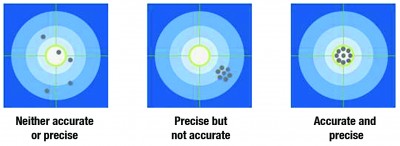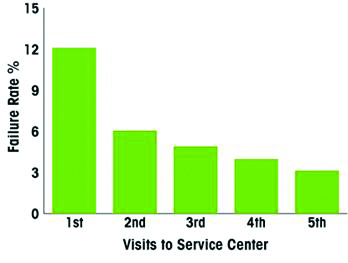Are you applying good pipetting practice?
11 Apr 2013 by Evoluted New Media
In terms of your liquid handling – by doing a little, you can improve a lot. Here is our guide to GPP
Many research experiments require the careful handling of precise volumes of liquid, making pipettes an essential tool for all life scientists. It is therefore vital that they are accurate and precise in order to produce good quality results. There are many factors which can influence the quality and reproducibility of the generated data, these include pipetting technique, pipette maintenance and calibration.
A complete pipetting system is comprised of the pipette, the pipette tip and the pipette user. Therefore the effect that all three elements can have on experimental outcome must be considered as a whole when trying to produce good, reliable results. So when you are evaluating the accuracy of your experimental data do not consider your pipettes in isolation.
To help improve the accuracy and reproducibility of your life science applications, you can apply some simple Good Pipetting Practice (GPP) guidelines.
Evaluation & Selection The first step is to evaluate your needs. Set out a plan of your project and determine your workflow. Once you have established this and have assessed the level of accuracy and precision you require, you will be able to evaluate the relevant tools and technologies available.
Your time and materials are expensive, so you need to carefully consider the liquid that you will be measuring, as this will greatly affect your pipette choice and its performance. If you are working with aqueous solutions an air displacement pipette would be the appropriate tool. Whereas for highly viscous or volatile samples a positive displacement pipette would be more suitable.
Another option to consider is whether to use an electronic or manual pipette, take time to think about the positives and negatives of each, before making a decision. A manual pipette is less expensive and simpler to use, however electronic pipettes are more consistent due to the motorised piston reducing user inconsistencies, are less dependent on pipetting technique and offer additional functionality. If you need to pipette multiple samples at once then a multichannel or adjustable spacer pipettes maybe suitable. Adjustable Spacer pipettes are especially usefully for quickly and easily transferring samples between different tube formats.
Once you have decided on the appropriate pipette for your application, you then need to choose the correct tip, ensuring that the design, quality and fit are right for your pipette. There are many different designs of tips, which all depend on your pipette choice, for air displacement pipettes there is a wide range of options that are fit for most application requirements. There are also specialist tips available, such as, aerosol-resistant filter tips, low-retention, extended length and gel loading tips. For positive displacement pipettes there is a large range of tips and syringes that are designed for problematic samples.
Tip quality is of the utmost importance; tips should be contamination free to ensure the integrity of samples, inert to eliminate impurities from the polypropylene and plasticiser leaching out of the plastic and should be manufactured in a Class 10,000 clean room.
Accuracy & Precision Ultimately the only reason for using a variable volume precision pipette is to enable exact, reproducible dispensing of liquids. A single droplet of reagent or sample so small that it can hardly be seen, can have major implications in research, quality control and clinical laboratories.
Accuracy and precision in pipetting is increasingly becoming a topic of discussion, particularly with manual pipetting systems. Pipetting requires both accuracy and precision in order to be error-free. However a pipette that is accurate may not be precise. It is essential that you understand the difference between accuracy and precision to truly understand how your pipette is performing.
Accuracy measures the difference between the volume of liquid that is delivered to the specified volume set, whereas precision indicates how close a group of measurements are to each other.
A pipette can be consistently inaccurate but this inaccuracy can be very precise, for example, if a pipette reads consistently low (Figure 1).
By simply ensuring that you are following the basic pipetting techniques correctly will help to minimise errors, for example your performance can be enhanced by up to 2.5% by simply making sure that you are pipetting at the correct immersion angle. Aspiration rates also affect performance, aspirating too quickly can cause liquid splash-up into the shaft, which can damage the piston and seal. Even without splashing, inconsistent aspiration can affect your accuracy by 1-5%. Other points to consider are your dispensing technique, if you are pre-wetting your tips and trying to avoid hand-warming your pipette body. There are a variety of pipetting techniques which you can use depending on your samples and your skill levels. Whatever your experience level is, it is always a good idea to refresh your knowledge of these techniques to ensure you are continually pipetting accurately and precisely and not introducing unwanted errors into your research.
Table 1 shows possible sources of error for pipettes, how to recognise the problem and ways of correcting them.
Ergonomics Probably the major topic of discussion in laboratories is the prevention of Repetitive Strain Injuries (RSI) through good ergonomics. Many scientific studies link fatigue due to badly designed non-ergonomic pipettes to poor pipetting performance. The cumulative effect of poor ergonomics over time impacts muscles, tendons, joints and nerves, severe risks being physical pain, interference with work and daily living, surgery or therapy and the potential need of a career change.

It is widely known that pipetting is a repetitive task; it is common for scientists to perform more than 500 hours of pipetting per year. With this in mind, a study published by Bjorksten et al found that pipetting anything over 300 hours per year or one hour a day increases the risk of hand and shoulder injuries . In order to alleviate some of the repetitiveness of pipetting, you should seriously consider the use of electronic pipettes for multi-dispensing, mixing and dilutions. Multichannel pipettes reduce repetition by 8 or 12 fold, and electronic multichannels reduce repetition even further. For high-throughput pipetting a 96-well pipetting platform can provide simultaneous pipetting into 96 wells with accuracy and efficiency.
Alongside the use of more ergonomic pipettes, there are ways of reducing repetition by simply ensuring you take frequent breaks, don’t go over 30 minutes without stepping away and trying to stretch and relax your shoulders, arms and hands. If it not convenient to take a break every 30 minutes then try changing tasks instead.
Keeping good posture is essential to safe pipetting practices; avoid excessive wrist flexion or extension, awkward neck positions or slouching forward over your desk. In order to help avoid these positions adjust your chair to ensure a good fit and practice good posture, organise your work area to make sure that everything you need is in reaching distance without having to over stretch. Also try keeping your elbows close to your body to prevent your shoulders from elevating and keep your wrists in a neutral position.
Although repetitiveness is the primary risk other factors, such as the forces required during pipetting are also present. Depressing the plunger, mounting and ejecting tips are all performed by the thumb. Muscles, ligaments and tendons in the thumb connect to many other parts of the hand and wrist, therefore overworking it can cause pain in other are
as of your body, including your neck, arm and wrist.
The force required to depress the plunger depends on the spring within the pipette. If spring forces are too light then seal resistance will slow the return of the plunger to the home position, but if spring forces are too heavy, then extra pressure is required to push the plunger down. Therefore checking the pipettes spring force and comparing old pipettes with new ones is essential in keeping pipetting forces to a minimum.
Tip ejection forces are known to be the highest of all pipetting activities, they differ between pipette models, so comparing pipettes before purchasing is essential. For
[caption id="attachment_32697" align="alignleft" width="200" caption="Keeping good posture is essential to safe pipetting practices; avoid excessive wrist flexion or extension, awkward neck positions or slouching forward over your desk"] [/caption]
[/caption]
universal (conical) tip systems, the ejection force is proportional to the force that the tip was originally applied, the greater the force used to mount the tip, the more will be required to eject it. However, using a tip that has a stop shelf inside will prevent over insert ion alleviating the pressure needed to eject it.
Gripping the pipette too hard can cause contact stress, so when looking for the right pipette for you, make sure it is well shaped to fit comfortably in your hand and has a good finger hook to allow minimum gripping force.
Calibration & Routine Operation Once you have chosen the right pipette for you, matched it up with the appropriate tips and perfected your technique to help prevent RSI and lower the risk of experiment failure, the only thing left to do is ensure you look after your pipette and keep it in good working condition.
The various mechanical parts in a pipette are often exposed to corrosive or hazardous chemicals, and, like all things mechanical, nothing lasts forever. Deterioration of parts will seriously affect performance, for example, seals can leak after being exposed to damaging piston surfaces or sample contamination, tip holders can be worn over time, especially if high force or banging is applied when mounting tips. Inefficient sealing can lead to leakage and incorrect sample volumes. Often, this leakage is gradual and may not be found until it is too late, adversely affecting the integrity of your science.
Generally pipettes checked yearly without any preventative maintenance or regular servicing procedures in place will have a 20% or more failure rate. Over 95% of failures are attributable to sealing system defects, which is predictable but preventable. Scheduled preventative maintenance by way of checking your pipette daily before use and establishing a routine for basic servicing will help to reduce failures and costs.
[caption id="attachment_32699" align="alignleft" width="348" caption="Generally pipettes checked yearly without any preventative maintenance or regular servicing procedures in place will have a 20% or more failure rate."] [/caption]
[/caption]
Alongside your in-house preventative maintenance getting your pipettes calibrated and serviced by a service centre is essential. When choosing a pipette service agency check that it complies with ISO:17025, even if your own laboratory is not accredited to this level. Only pipette service agencies holding this standard can guarantee the quality and traceability of the work being performed on your pipette. Not all service organisations achieve this standard, many achieve the minimal ISO:9001, which although acceptable for most office protocols, does not assess the actual technical ability, competency and efficiency with which the procedures are performed.
References: 1. Bjorksten, M., et al: Applied Ergonomics 1994















